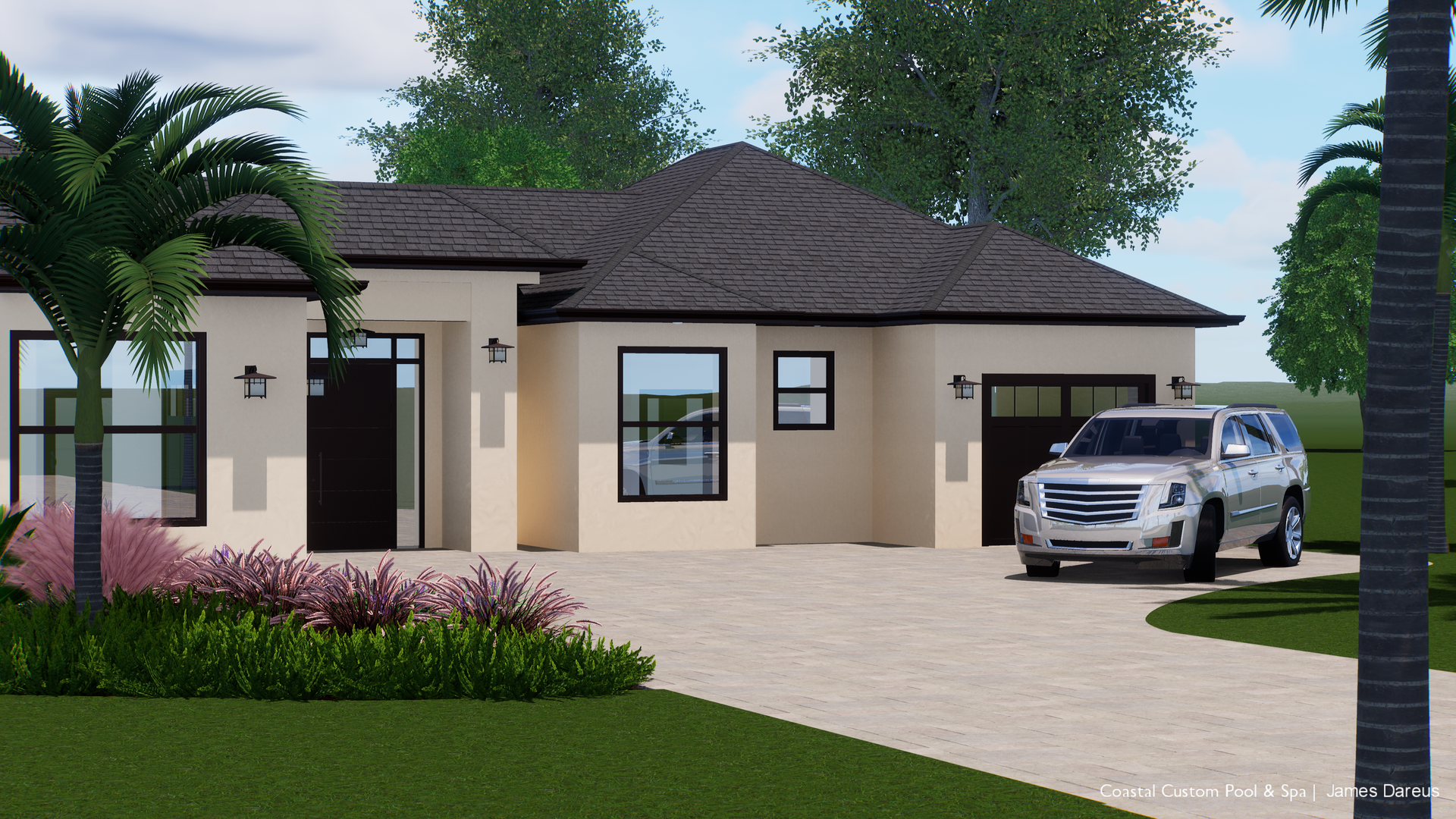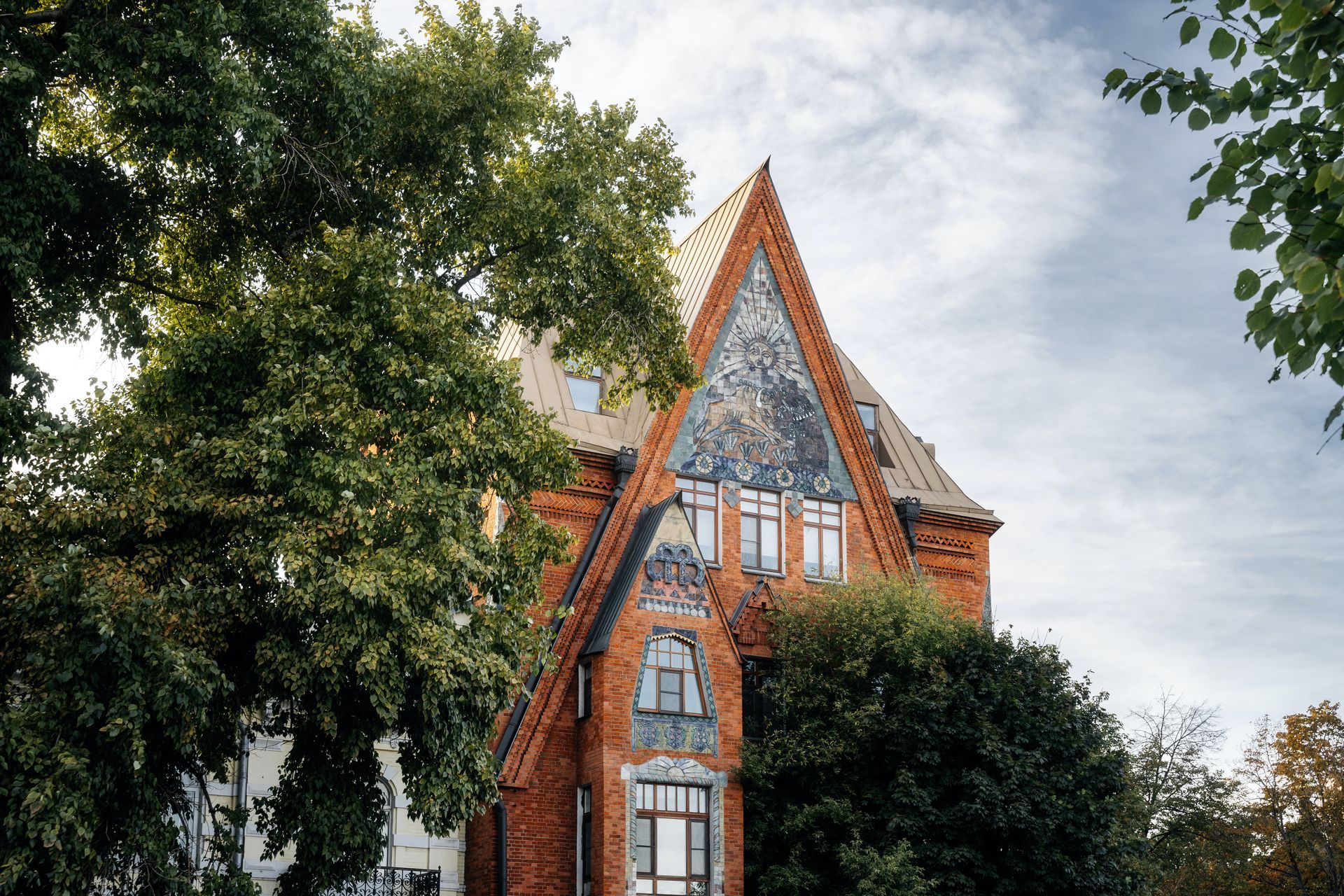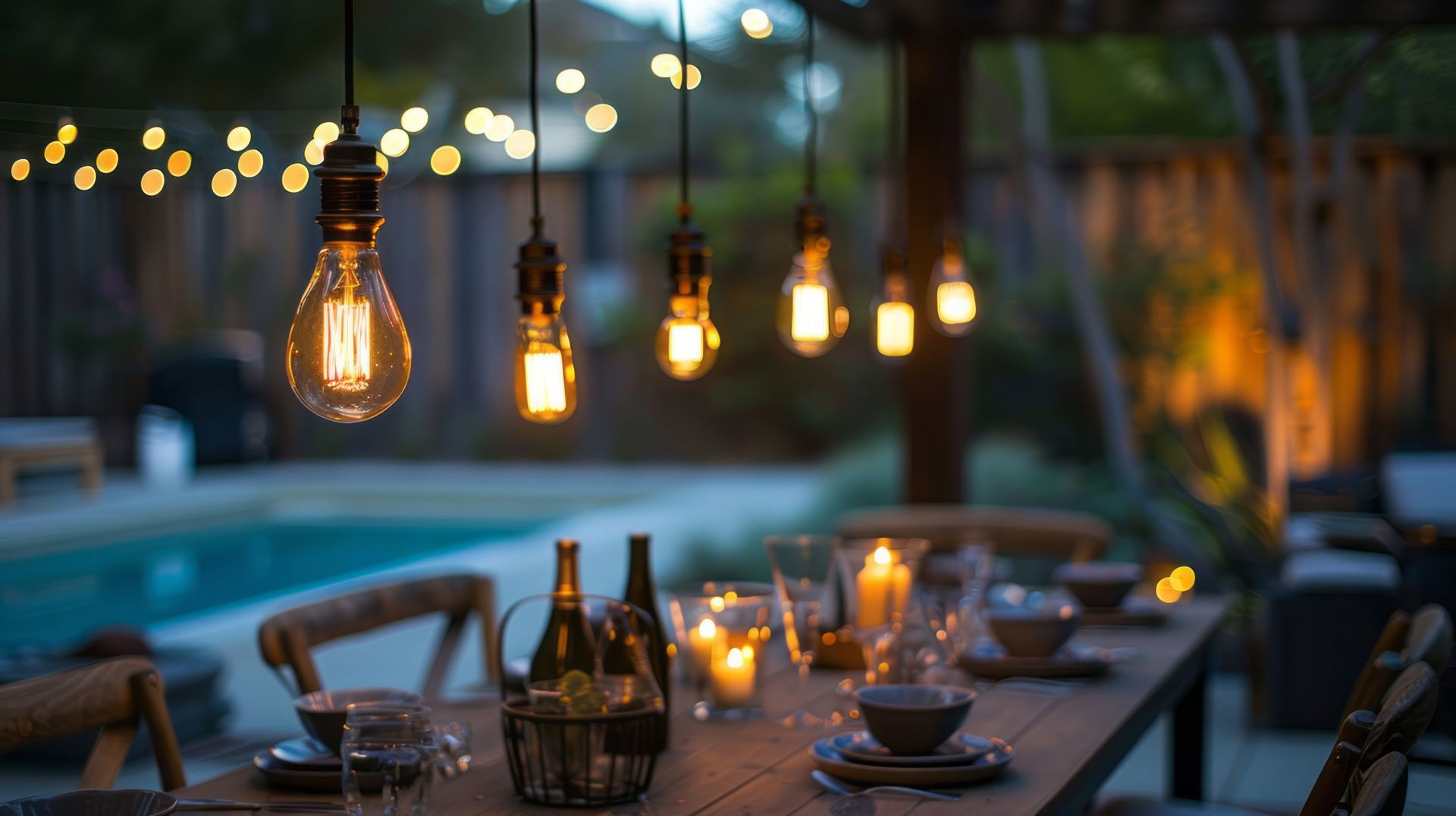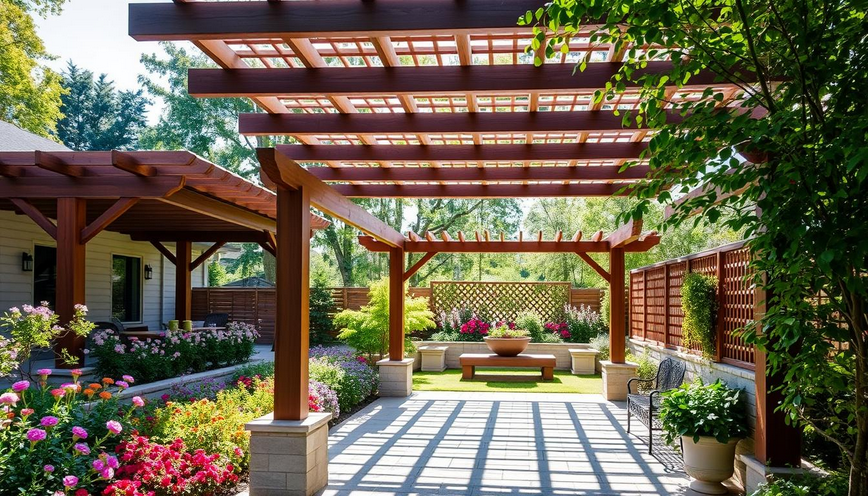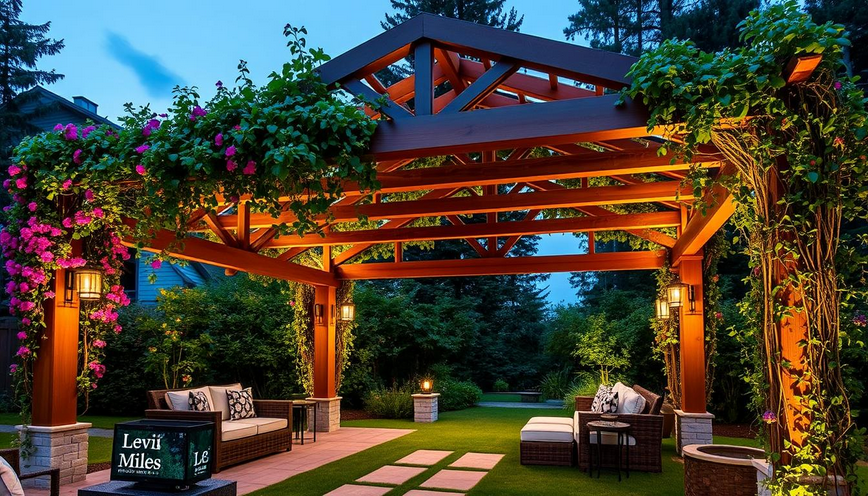
Design Blog
How to pick the perfect pergola
For homeowners, crafting an inviting and functional outdoor living space is paramount. A well-designed pergola stands out as a pivotal element in transforming your backyard into a serene retreat. With a historical lineage dating back to the 1400s, the term "pergola" was first documented by Sir John Evelyn in 1645 1 . Today, these structures are crafted from a diverse array of materials including fiberglass, aluminum, cellular PVC, steel, and vinyl 1 . This guide aims to provide expert advice on selecting the ideal pergola to elevate your swimming pool area or outdoor space .
Key Takeaways
- Pergolas have been around since the 1400s and are made from a variety of modern materials.
- Selecting the right pergola design and material can significantly improve the look and function of your outdoor living area.
- Factors to consider include your backyard space, intended use, budget, and personal style preferences.
- Pergolas can be freestanding or attached, and come in a range of sizes to fit any space.
- Regular maintenance is important, especially for wood pergolas , to ensure long-lasting enjoyment.
What is a Pergola?
A pergola is an architectural marvel, characterized by its columns that uphold a complex network of beams, rafters, and stringers 2 . These structures are integral to outdoor living spaces, offering shade and serving as the skeleton for an outdoor room or dining area 3 . Unlike gazebos, which boast a comprehensive roof, pergolas provide a more open design, ensuring partial shade and unobstructed airflow.
Definition and Purpose
The term "pergola" is derived from the Latin "pergula," meaning a projecting eave 2 . These structures are multifunctional, capable of standing alone or integrating seamlessly with a building, thus enhancing outdoor areas with both style and utility 3 . Their core function is to establish a shaded, semi-private enclave for leisure, dining, or social gatherings.
Differences Between Pergola, Gazebo, Arbor, and Trellis
Despite their similarities, pergolas, gazebos, arbors, and trellises cater to distinct needs. Gazebos, for instance, are self-contained with a full roof, whereas arbors are primarily employed as gateways or pathways 3 . Trellises, on the other hand, are lattice frameworks that support climbing plants 2 . Pergolas, with their open-air framework, offer a versatile solution, fitting either as standalone features or as extensions to buildings.
- Pergolas generally surpass arbors in size and cost 2 .
- The construction of a pergola can range from $1,000 to $4,000, influenced by the type of wood, size, and intricacy of the design 2 .
- Some pergolas incorporate fiberglass or retractable canopies for weather protection 2 .
- These structures, along with arbors, trellises, and latticework, are traditionally employed to support climbing plants 2 .
- Gazebos, constructed from wood, are distinguished by their enclosed roof, elevated floor, and circular form 2 .
- Carports, designed for automobile shelter, often mirror pergolas in their architectural style 2 .
In conclusion, a pergola stands out as a unique and adaptable outdoor feature, capable of elevating the aesthetics and functionality of any backyard or patio 3 . Its open design and customizable elements make it a favored option for those aiming to craft a serene and welcoming outdoor retreat.
History of Pergolas
Pergolas have a storied history, tracing back to ancient civilizations. The earliest known garden pergola emerged around 1400 BC in ancient Egypt 4 . These structures have evolved over the centuries, mirroring the evolution of garden design trends and preferences.
The term "pergola" was first employed by Sir John Evelyn in an Italian context in 1645, although the concept predates this by centuries 5 . Roman aristocrats favored pergolas, adorning them with climbing grape vines for outdoor living spaces 4 .
In the 19th century, a shift towards naturalistic gardening transformed pergola design 4 . These structures were integral to wine-making, supporting grape vines for centuries 4 . Notably, Leonardo da Vinci embellished the Sala delle Asse of the Castello Sforzesco in Milan in 1498 with an illusionary pergola, crafted from the intertwined branches of sixteen massive mulberry trees 5 .
Unlike the ephemeral green tunnels of medieval and Renaissance gardens, pergolas are enduring architectural elements. They were constructed from springy withies, which were easily replaceable shoots of willow or hazel 5 . Today, modern pergolas are crafted from a variety of materials including wood, vinyl, fiberglass, aluminum, and chlorinated polyvinyl chloride (CPVC), offering a low-maintenance alternative to traditional materials 5 .
The Hill in Hampstead, London, boasts a comprehensive pergola designed by Thomas Mawson for W. H. Lever 5 . Similarly, the pergola in Wrocław, established in 1911, was designated a UNESCO World Heritage Site in 2006 for its distinctive design and historical importance 5 . Traditional pergolas serve a dual purpose, providing a framework for climbing plants to flourish while also enhancing garden aesthetics 5 .
Parts of a Pergola
Pergolas, as outdoor structures, embody versatility and complexity, comprising several essential components. A comprehensive understanding of these elements facilitates the design and selection of an ideal pergola for one's backyard. This discourse will delineate the pivotal components that define a pergola's structure: 6
Columns
The columns, pivotal in supporting the pergola, are typically constructed from materials such as wood, aluminum, or steel. They are anchored to concrete footings, ensuring stability and robustness 6 . Freestanding pergolas necessitate a minimum of four columns, whereas attached pergolas require at least two columns on the open side, underscoring their structural importance 6 .
Beams
The beams, integral to the pergola's framework, span its width, supported by the columns . They lay the groundwork for the rafters and stringers . While freestanding pergolas feature two beams, attached pergolas employ a beam alongside a ledger board on the wall, showcasing versatility in design 6 . The beam's ends can be tailored with traditional scrolled or contemporary angled designs, harmonizing with the pergola's aesthetic 6 .
Rafters
Installed perpendicularly across the beams, rafters are a critical component of the pergola's structure. Their ends, adorned with traditional or angled designs, contribute both to the pergola's functionality and its visual appeal 6 .
Stringers/Purlins
Stringers , or purlins, parallel to the beams and perpendicular to the rafters, add depth and visual intrigue to the pergola. Their uniform spacing enhances shade and aesthetic appeal 6 .
Ledger Board
In the context of attached pergolas , the ledger board is integral, affixed to the support wall. It serves as a substitute for a beam, supporting the rafters where they intersect the building, highlighting its crucial role in the structure 6 .
Popular Pergola Materials
The selection of the ideal pergola material is paramount in enhancing outdoor spaces. The spectrum ranges from the inherent elegance of wood to the practicality of aluminum and vinyl, each material presenting distinct benefits and considerations. This discourse aims to delineate the most prevalent pergola materials and their inherent attributes.
Wood Pergolas
Wooden pergolas, typically fashioned from cedar or redwood, imbue gardens or patios with a natural, rustic ambiance. These structures can be tailored with stains or paints to harmonize with diverse design motifs. However, they necessitate regular maintenance to avert weathering, fading, rotting, and potential splintering 7 .
Aluminum Pergolas
Aluminum pergolas stand out for their versatility, resilience, and minimal upkeep. Their lightweight nature makes them resistant to weathering, rust, and rot, obviating the need for frequent staining or painting 8 . These structures can be finished in a plethora of colors and mimic wood grain through sublimation. An annual cleaning regimen is sufficient to preserve their aesthetic appeal.
Steel or Metal Pergolas
Steel pergolas epitomize strength and durability, often weighing 2.5 times more than aluminum 7 . This robustness enables them to span larger areas than their counterparts. Steel is typically coated with powder or liquid paint to deter oxidation and rust, necessitating periodic touch-ups to maintain its appearance.
Fiberglass Pergolas
Fiberglass pergolas boast exceptional strength, permitting wider column spans than other low-maintenance options. They can be tailored to either blend seamlessly with the landscape or serve as a striking focal point. The hollow nature of fiberglass facilitates the integration of lighting, fans, and heaters, with minimal upkeep required beyond routine cleaning.
Cellular PVC Pergolas
Cellular PVC (cPVC) emerges as a synthetic alternative to traditional wood. Its inherent resistance to moisture, splitting, and rot makes it virtually impermeable to environmental elements and completely termite-resistant 8 . cPVC maintains its color vibrancy and demands minimal maintenance, limited to periodic cleaning.
Vinyl Pergolas
Vinyl pergolas represent a resilient, low-maintenance solution for outdoor settings. Unlike wood, vinyl is impervious to rot, warp, and the need for frequent staining 8 . These structures endure harsh weather conditions and retain their appearance with minimal upkeep. Yet, they may lack the organic allure of wood and exhibit reduced customization potential.
In the quest for the ideal pergola material, one must weigh factors such as durability, maintenance demands, and the desired aesthetic. Each option presents unique advantages, underscoring the importance of selecting a material that aligns with personal preferences and the specific requirements of the outdoor space 7 8 .
Pergola
Pergolas are a favored outdoor structure, enhancing the aesthetic and functionality of backyards and gardens. These frameworks, akin to gazebos, offer shelter for terraces or connect different areas 9 . Traditionally, they feature vertical posts and horizontal beams, creating shaded pathways or seating areas.
While pergolas resemble arbors and trellises, their distinct purpose and design set them apart. Unlike pagodas, with their tiered towers and oriental flair 9 , pergolas are larger, practical, and versatile for various outdoor living needs.
Available in materials from traditional wood to modern aluminum or steel 10 , pergolas can be freestanding or attached to a home. Their customization options ensure they complement the home's architecture and personal style preferences.
The influence of Japanese design and Zen gardens has popularized pagodas in modern gardens, especially in the UK 9 . Yet, pagodas differ from pergolas by offering sheltered seating rather than shaded pathways 9 . Modern garden structures, such as louvre roofs, provide automated or retractable features for added versatility 9 .
When deciding between a pergola, pergoda, or pagoda, consider sunlight filtration, maintenance, and aesthetic appeal 10 . Pergodas might need more upkeep due to their decorative elements, whereas pagodas offer substantial shade with their tiered design 10 . The ideal choice hinges on your specific outdoor living needs and preferences.
Choosing the Right Pergola Type
Enhancing your outdoor living space significantly hinges on the type of pergola you select. Various pergola options exist, each offering distinct benefits and considerations. This exploration delves into the different pergola types and their potential to transform your backyard.
Freestanding Pergola Kits
Freestanding pergolas stand alone, allowing for versatility in placement. They can serve as a focal point, create a designated gathering area away from the house, or integrate seamlessly with your garden design. 11 These structures provide the freedom to tailor the structure to your specific needs and preferences.
Attached Pergola Kits
Attached pergolas are installed directly against the side of a house or other existing structure, creating a seamless transition between indoor and outdoor living spaces. These pergolas are favored for extending a home's usable square footage, offering a covered outdoor area just steps away from the interior. Attached pergolas are well-suited for smaller yards or when you want the benefits of a pergola without sacrificing too much yard space.
Louvered Pergolas
Louvered pergolas feature adjustable slats that allow you to control the amount of sunlight filtering through, providing flexible shade as needed. These pergolas are particularly popular for their blend of practicality and modern, sleek design. The adjustability of the louvered roof makes louvered pergolas a great choice for those who desire versatility in their outdoor living spaces.
When selecting the right pergola type for your outdoor space , consider factors such as your available area, the desired level of shade and privacy, and your personal style preferences 11 12 . By carefully evaluating these factors, you can choose the pergola that best suits your needs and enhances the overall aesthetic of your backyard.
Best Pergola Sizes
When selecting the perfect pergola size, it's essential to align it with the dimensions of your outdoor space. A large pergola might dominate a diminutive yard, whereas a diminutive one could seem incongruous in expansive surroundings. The optimal pergola dimensions must resonate with the scale of your backyard 13 .
Popular pergola sizes span from 10'x10' to 10'x13', creating an inviting, balanced shaded area for various activities such as seating, dining, or relaxation 13 . These dimensions may fluctuate in width from 8-24 feet and length from 8-40 feet, providing versatility in design 13 .
Freestanding pergolas, often more budget-friendly and simpler to maintain, contrast with attached structures 13 . They come in a variety of pergola sizes, from 8'x8' to 24'x40', ideal for various settings including patios, decks, or slabs, contingent upon adequate foundation support 13 14 .
Choosing between larger and smaller pergola sizes is not a matter of right or wrong. Smaller pergolas offer adaptability, whereas larger ones encourage more elaborate designs 13 . The largest standard pergola, with 4 posts, measures 12'x20', while those with 6 posts are classified as "super pergolas," providing enhanced structural support and cost-effectiveness 13 .
Pergola dimensions can be tailored to meet specific requirements, encompassing post sizes, beam lengths, and overall structure height 13 . Elements such as fire pits, outdoor kitchens, hot tubs, and furniture can seamlessly integrate into pergola designs due to their structural integrity 13 .
Optimal pergolas blend low maintenance with high functionality, utilizing quality materials and straightforward designs 13 . The strategic placement of pergolas is vital for maximizing shade and protection from environmental elements within the outdoor living area 13 .
In conclusion, prevalent pergola sizes span from 10'x10' to 10'x13', with customization options to align with your outdoor space and aesthetic preferences 13 14 15 .
Factors to Consider When Choosing a Pergola
When contemplating the acquisition of a pergola, a meticulous evaluation of your backyard's dimensions is paramount. Assess the spatial availability and envision whether a standalone or integrated structure aligns with your aspirations 16 . Achieving a seamless integration of the pergola within your backyard is vital for crafting a unified and practical outdoor sanctuary.
Evaluate Your Backyard Space
Ascertain the pivotal role you envision for your pergola. Will it offer shade for lounging or dining? Support climbing plants? Or delineate a distinct area within your landscape 16 ? Clarifying the pergola's intended function will steer your selection towards the optimal size, style, and attributes.
Identify the Purpose of the Pergola
The financial implications of a pergola selection are multifaceted, influenced by its dimensions, material, aesthetic, and brand. Consider not only the initial expenditure but also the potential costs associated with installation and upkeep 16 . Opting for a resilient material like aluminum may lead to reduced maintenance expenses over the long term, albeit at a potentially higher initial cost.
Establish a Budget
The aesthetic impact of your pergola's style and material on your outdoor domain cannot be overstated 16 . Traditional wooden pergolas exude a rustic allure, whereas contemporary aluminum or steel alternatives offer a streamlined, minimalistic appeal 17 . Reflect on how the pergola's visual congruence with your domicile's architecture and landscaping will influence your decision.
Choose Pergola Style and Material
The material selection for your pergola significantly affects its cost, upkeep demands, and visual impact on your outdoor retreat 17
. Deliberate on the advantages and disadvantages of diverse materials, including wood, vinyl, fiberglass, and aluminum, to ascertain the optimal match for your requirements and financial constraints 16
17
.
Installation and Maintenance
Ensuring proper pergola installation is paramount for the enduring stability and safety of your outdoor sanctuary 18 . Irrespective of the material—wood, metal, or synthetic—it is imperative to adhere to the manufacturer's guidelines meticulously or seek professional assistance when necessary. Such meticulous installation guarantees the pergola's resilience against environmental forces, thereby ensuring prolonged enjoyment 18 .
Equally vital is the commitment to pergola maintenance to sustain its aesthetic and functional integrity over time 18 . Wooden pergolas, with diligent care, may extend their lifespan from 5 to 12 years, while synthetic alternatives can endure nearly 15 years with minimal upkeep, potentially stretching to 20 years with consistent maintenance 18 .
Essential maintenance routines encompass cleaning, inspecting for structural weaknesses, and addressing signs of deterioration 19 . For wooden pergolas, employing a soft brush or cloth for cleaning is advised to protect the material integrity 19 . To maintain the original hue of a wooden pergola, reapplying stain biennially and sealing triennially is recommended 18 . Periodic staining or painting, ideally every five years, with a preference for biennial touch-ups, is essential for preservation 18 .
During the summer, maintenance should include scrutinizing the pergola for any loose components, cleansing it thoroughly, and trimming nearby vegetation to avert damage 18 . Pergolas necessitate consistent upkeep to continue enriching your outdoor domain 18 . Neglecting minor issues, such as loose fastenings, can precipitate a premature pergola demise 18 .
Despite their aesthetic allure, pergolas demand an understanding of the maintenance they require, contingent on their material 19 . In terms of maintenance effort, pergolas are akin to outdoor furniture but slightly more demanding, adding a few extra hours to your summer upkeep regimen 19 . An annual review is advisable to pinpoint any maintenance tasks, such as reapplication of stain, sealing, or repairs, to avert deterioration over the pergola's lifespan 19 .
Adhering to the manufacturer's guidance and consistent maintenance ensures your pergola remains a cherished element of your outdoor retreat for extended periods 18 . Depending on the design, a pergola might not offer comprehensive sun protection, necessitating consideration of alternatives like a louvered pergola for enhanced shade management 18 .
Conclusion
Choosing the ideal pergola for your outdoor realm necessitates a meticulous evaluation of size, material, style, and purpose 20 . By scrutinizing your backyard's layout and pinpointing your requirements, you can select a pergola that not only complements your landscape but also augments your outdoor living ambiance 21 . Whether your preference leans towards a traditional wood design, a contemporary aluminum framework, or a multifunctional louvered model, the right pergola can metamorphose your backyard into a serene retreat.
Pergolas are celebrated for their visual appeal and their role in landscaping, potentially elevating property value by up to 15% as per industry specialists 20 . The expenditure for a bespoke pergola spans from $3,500 to $7,000, influenced by the choice of materials and the expertise of the craftsmen 20 . Conversely, opting for a DIY kit can significantly reduce costs to approximately $1,500 to $2,000 20 . Ultimately, the optimal pergola emerges as a striking focal point, offering shade, a platform for climbing plants, and a venue for leisure and social gatherings.
Delving into the historical context, structural elements, and material options of pergolas 22 empowers homeowners to make a well-informed choice that resonates with their financial constraints, aesthetic inclinations, and the unique demands of their outdoor space 21 . Through meticulous planning and discernment, a pergola can emerge as a cherished and practical element of any backyard, enriching the visual and functional aspects of the outdoor living domain.
FAQ
What is a pergola and what is its purpose?
A pergola is an architectural feature characterized by its columns and a lattice of beams and rafters. It's primarily designed to augment outdoor living spaces, providing shade or a framework for dining or relaxation areas. Unlike gazebos, which offer full roof coverage, pergolas allow for sunlight penetration and airflow, thanks to their open design.
How do pergolas differ from other outdoor structures?
Pergolas, gazebos, arbors, and trellises all share some commonalities but cater to distinct purposes. Gazebos feature a complete roof, making them standalone structures. Arbors are typically employed as gateways or pathways. Trellises support climbing plants with their lattice framework. Pergolas, however, stand out for their versatility, offering an open-air structure that can be either freestanding or integrated with a building.
What are the essential components of a pergola?
The fundamental elements of a pergola encompass columns, beams, rafters, stringers/purlins, and a ledger board for attached models. Columns bear the beams, which span the pergola's width, with the number varying by structure size. These components come in diverse styles, ensuring the pergola complements the overall design intent.
What are the different materials used for pergolas?
Pergolas can be crafted from wood, aluminum, steel, fiberglass, cellular PVC, and vinyl, each material offering distinct advantages in terms of longevity, upkeep, and visual appeal.
What are the different types of pergolas?
Pergolas are categorized into freestanding and attached types. Freestanding models are independent structures, offering flexibility in placement. Attached pergolas, on the other hand, are integrated with a house or existing structure, creating a fluid transition between indoors and outdoors.
What factors should I consider when choosing a pergola?
Selecting a pergola requires an evaluation of your outdoor space dimensions, the pergola's intended function, your financial constraints, and the desired style and look. Assessing your backyard and identifying your needs will guide you in choosing the appropriate pergola type, size, and features.
How do I ensure proper installation and maintenance of my pergola?
Ensuring the correct installation is paramount for your pergola's stability and safety. Adhere to the manufacturer's guidelines or seek professional assistance if necessary. Regular maintenance, encompassing cleaning, inspecting for loose components, and addressing weather-related damage, will maintain the pergola's appearance and functionality over its lifespan.
Source Links
- https://structureworks.com/pergolas-101-a-guide-to-choosing-the-right-pergola-design/ - Pergolas 101 – A Guide To Choosing The Right Pergola Design - Pergolas and Shade Structures | Structureworks
- https://www.thespruce.com/what-is-a-pergola-2131097 - How Do Pergolas Differ From Arbors?
- https://kloterfarms.com/what-is-purpose-point-pergola/ - What is the Purpose (And Point) of a Pergola? Pergolas vs. Gazebos
- https://mgcdecks.com/uncategorized/history-of-pergolas/ - Tracing the Evolution: The Fascinating History of Pergolas
- https://en.wikipedia.org/wiki/Pergola - Pergola
- https://plasticlumberyard.com/what-are-the-parts-of-a-pergola/ - The Parts Of A Pergola | Custom Pergola Design
- https://www.konacontractors.com/blog/3-best-materials-to-consider-using-for-your-pergola/ - 3 Best Materials To Consider Using for Your Pergola
- https://hansohome.com/blogs/all-about-pergolas/best-pergola-material?srsltid=AfmBOoqLXbPTxHPr2Q_X2xv3cuGiP1ZYlSJHlE89YTRFRmA148LAc4Wc - Best Pergola Material: Vinyl, Wood, or Aluminum?
- https://www.iqoutdoorliving.co.uk/what-is-the-difference-between-a-pergola-pergoda-and-pagoda/ - What is the difference between a Pergola, Pergoda and Pagoda? » IQ Outdoor Living
- https://timberdiy.com/blogs/news/what-s-the-difference-between-a-pergola-pergoda-and-pagoda?srsltid=AfmBOopWmOG3QYWwx6sYf9dF6uWdh0wex63xAzvVr2FR_L12LWeEyy9P - A Pergola, Pergoda And Pagoda, What’s The Difference?
- https://www.bhg.com/what-is-a-pergola-6752583 - What Is a Pergola? Plus How to Choose the Right One for Your Yard
- https://guide.archiexpo.com/choosing-the-right-pergola/ - Choosing the Right Pergola - Buying Guides ArchiExpo
- https://theluxurypergola.com/blogs/louvered-roof-info/pergola-dimensions-the-best-size-pergola-for-you?srsltid=AfmBOormxgqiO9nrdL2T_YIs5RTa_oM4mURWj7GN4-spt4S0HcSYdxWa - Pergola Dimensions: The Best Size Pergola For You
- https://hansohome.com/blogs/all-about-pergolas/pergola-size-guide?srsltid=AfmBOoogwmWLEYECnbjp3Wc9RG4UixsLGWRfodPNpjIQNEtrBzAxzzgM - Pergola Size Guide: How to Choose Ideal Dimensions
- https://www.vinyl-pergola-kits.com/blog/pergola-design/pergola-size-guide - The Pergola Size Guide | Pergola Sizes & Measurements for Your Home
- https://www.hardieboysinc.com/aspects-to-consider-while-choosing-a-pergola-for-your-yard/ - Modern Pergola | Upgrade Outdoor Space With A Vinyl Pergola
- https://www.oakio.com/blog/how-to-choose-the-best-outdoor-pergola/ - How to Choose the Best Outdoor Pergola? - Oakio Plastic Wood Building Materials Company
- https://rollac.com/pergola-maintenance-and-care/ - Pergola Maintenance & Care: The Complete Guide | Rollac
- https://pergoladepot.com/pergola-maintenance-tips-for-the-summer-months/ - Pergola Maintenance Tips for Summer Months
- https://lancastercountybackyard.net/blog/purpose-of-a-pergola/ - Purpose Of A Pergola - Ideas & Benefits | LCB
- https://theluxurypergola.com/blogs/louvered-roof-info/pergola-vs-patio-cover-which-should-you-choose?srsltid=AfmBOorrYvffizIJQoLoZ4r9bvChQmMu5-_nhXp0mqTPEFp2iU1pwpFF - Pergola vs Patio Cover. Which should you choose?
- https://hansohome.com/blogs/all-about-pergolas/what-is-a-pergola?srsltid=AfmBOord973okCE6lJPD9nCgevV1_FfLbYuZ2cyXQD6EoadM0RIajP6f - What is a Pergola and What Is It Used For?
share this
STAY UP TO DATE
GET the LATEST from levi miles.
Receive a notification when we got something new to share.
Contact Us
